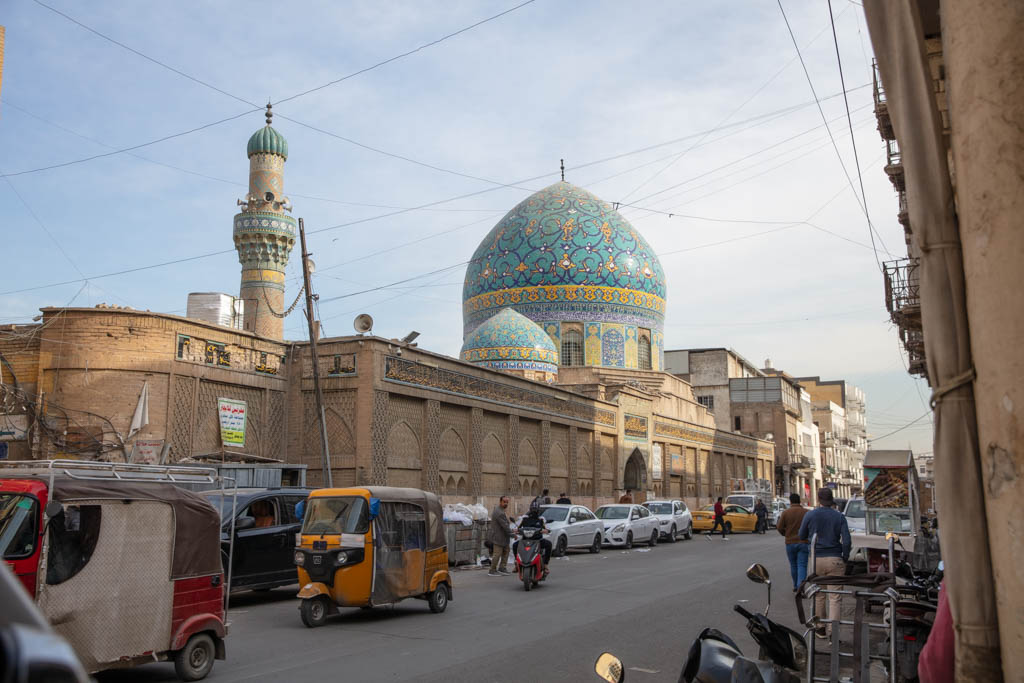
One Week Iraq Itinerary
Updated April 2024, One Week Iraq Itinerary was originally published in May 2022
In the past year since Iraq began opening up to tourism a bit more with the ease of a visa on arrival available to many nationalities, now is the perfect time to plan your first trip to the country packed with countless historical sites and some of the friendliest people you’ll ever meet. But you don’t have that much time- don’t worry, it’s possible to hit the highlights of Iraq in just one week using this guide I’ve created below.
Start planning: The Iraq Travel Guide with everything you need to know for both Federal Iraq and Iraqi Kurdistan
Need Travel Insurance and Evacuation Services for Iraq?
Start shopping for travel insurance plans over at IATI Insurance. Readers of the Adventures of Nicole get a 5% discount off your plan.
The Adventures of Nicole partners with Global Rescue to offer the world’s leading medical evacuation and security advisory services. To travel with peace of mind, shop evacuation coverage at Global Rescue.
Wanna join a tour to Iraq? Check out this April 2022 Iraq group trip on offer or sign up for updates below if you’re not quite ready to sign up!
7 Day Iraq Itinerary
Day 1: Baghdad
Day 1 Iraq Itinerary: Mustanasiryah Madrasa, Safafeer Copper Market, Al Mutanabi Street, Al Rasheed Street, Tahrir Square, Al Kadhimiyah Mosque
Start your journey to Iraq with the capital city of Baghdad. While it’s not the most glamorous looking city at first glance, there is plenty of fun and fascinating things to do. After you’ve had breakfast, grab a taxi or Careem to the Mustanasiryah Madrasa to pay a visit to the 13th century Islamic school, one of the oldest Islamic universities in the world.
Once you’ve finished up at Mustanasiryah, walk over to the nearby Safafeer Copper Market to have a look through the wares on sale. There are more than just copper lamps, plates, and trays for sale in the market too- some of the best Iraqi souvenir shopping is found right here at Safafeer. Once you’ve had your fill exploring the stalls of Safafeer, make the short walk over to Al Mutanabi Street.
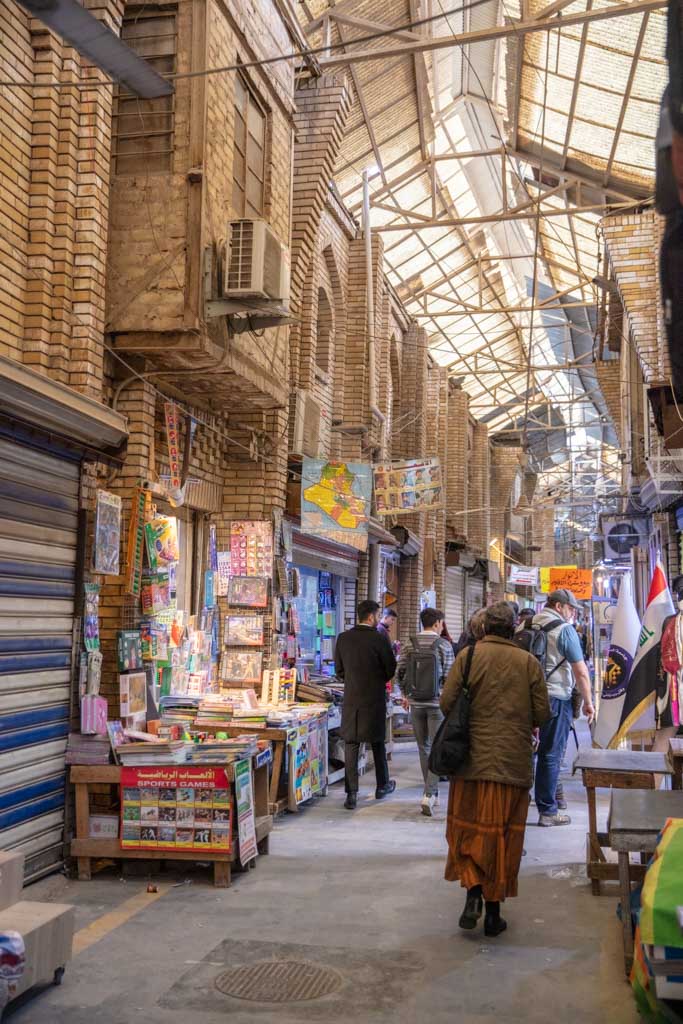
Al Mutanabi Street feels like the heart of Baghdad with its plethora of shops selling books and stationery, and lively cafe scene. At the southern end of Al Mutanabi Street, you’ll find a statue of the famous Abbasid-era poet for which the street is named, overlooking the Tigris River. A short stroll to the northwest and you’ll see the 19th century Ottoman Qishleh Clock.
Head back up Al Mutanabi Street and pop into the over century-old Shabandr Cafe for some chai and nargilé (hookah) before heading toward Al Rashid Street.
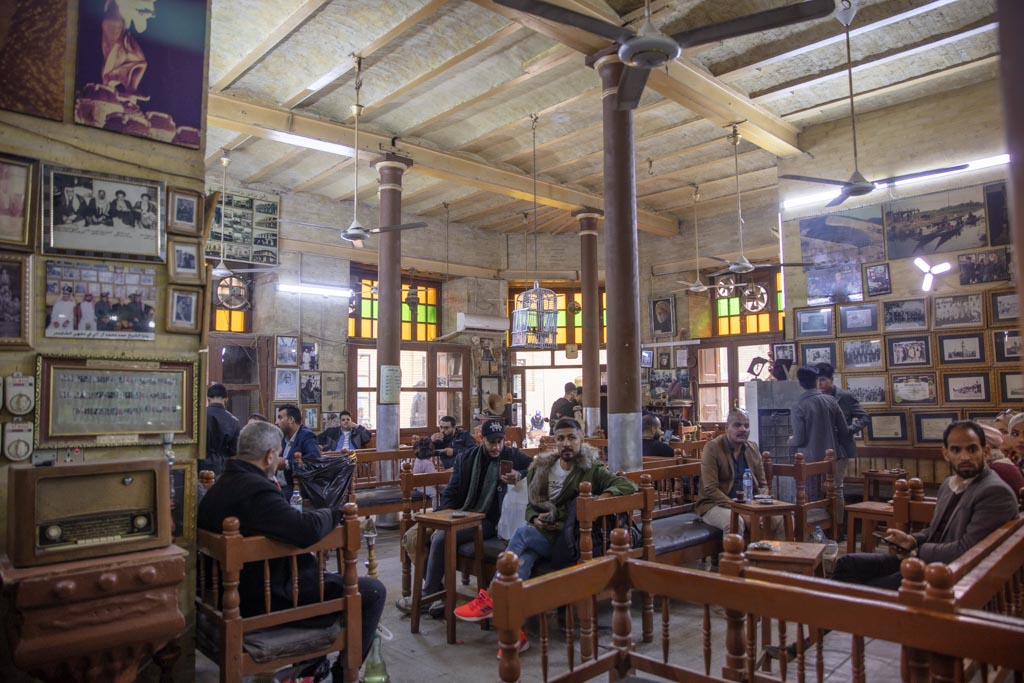
Continuing onto Al Rashid Street, one of Baghdad’s historical centers, admire the old buildings and grab a quick lunch at one of the many shawarma cafes outside.
Before the shops on Al Rashid start to close (they usually are completely shut by 3 pm), make sure to grab a glass of juice at the famous Haj Zebala Juice Shop (I liked the pomegranate best, but locals seem to prefer the grape/raisin). Haj Zebala has been around for over 100 years and owner Haji Mohammad Abdel Ghafour is the third generation of this family to have continued on the legacy. A glass of juice will set you back 1,000 IQD.
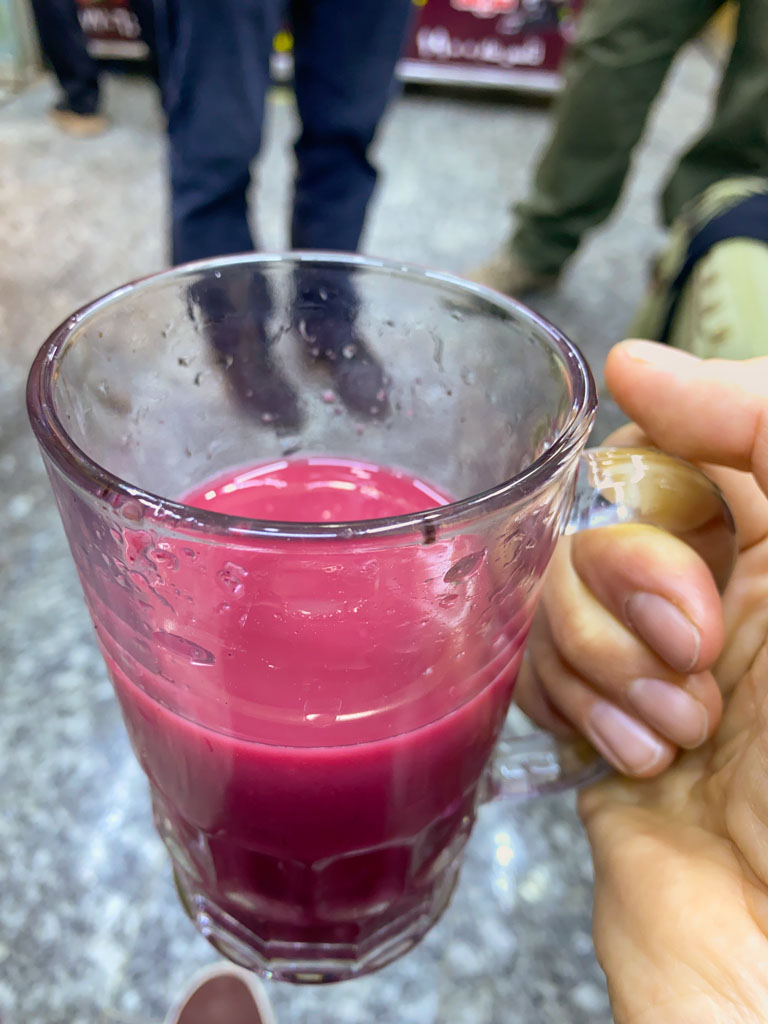
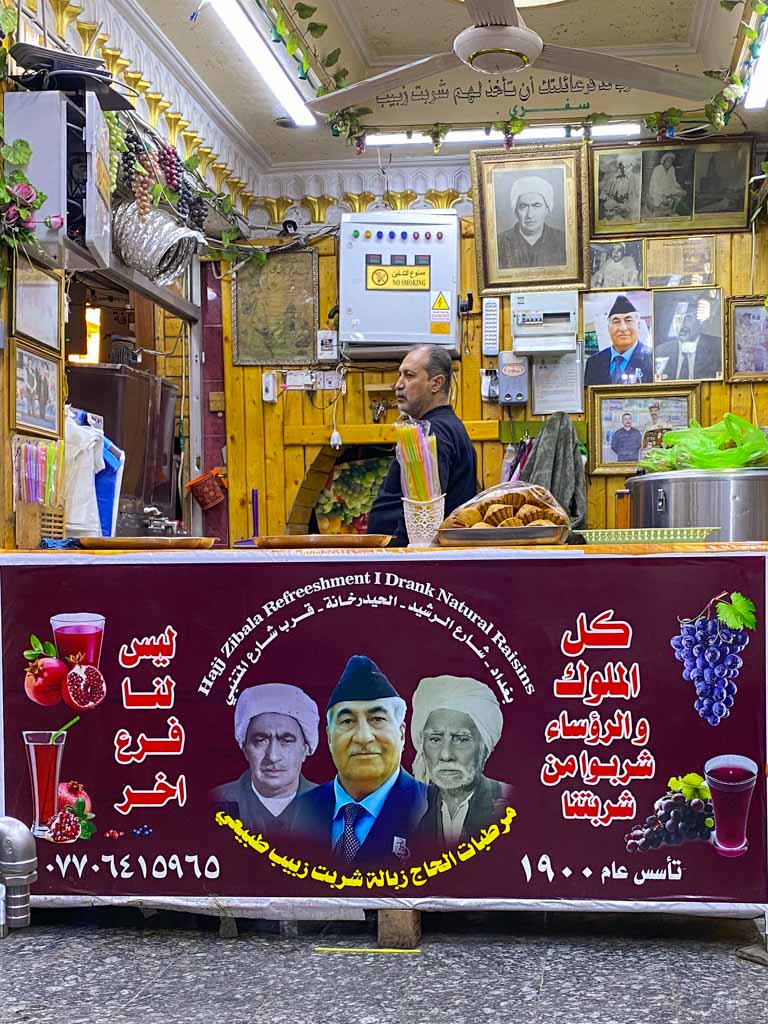
In the later afternoon take some time to visit the famous Tahrir Square as most everything on Al Mutanabi and Al Rashid has shut down for the day.
Tahrir Square was the center of the 2019-2021 Iraqi Protests where frustrated Iraqi citizens protested against widespread corruption, political sectarianism, high unemployment, among other problems in hopes of making changes to instill a brighter future for the nation. Make sure to wander away from the square and into the tunnel to the southeast to check out the phenomenal Tahrir Square Murals painted on the tunnel walls by protesters.
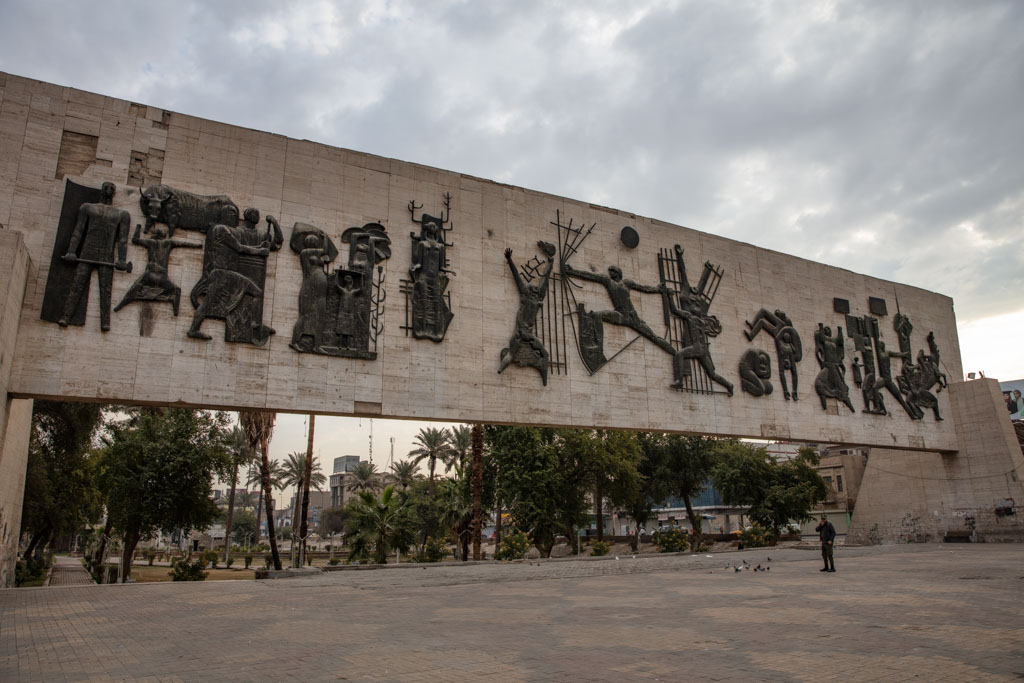
Once you have finished checking out Tahrir Square, head for your hotel to rest for a little while before grabbing dinner (I’d recommend some of Baghdad’s famous masgouf). Finally, end your day with an evening visit to Al Kadhimiyah Mosque.
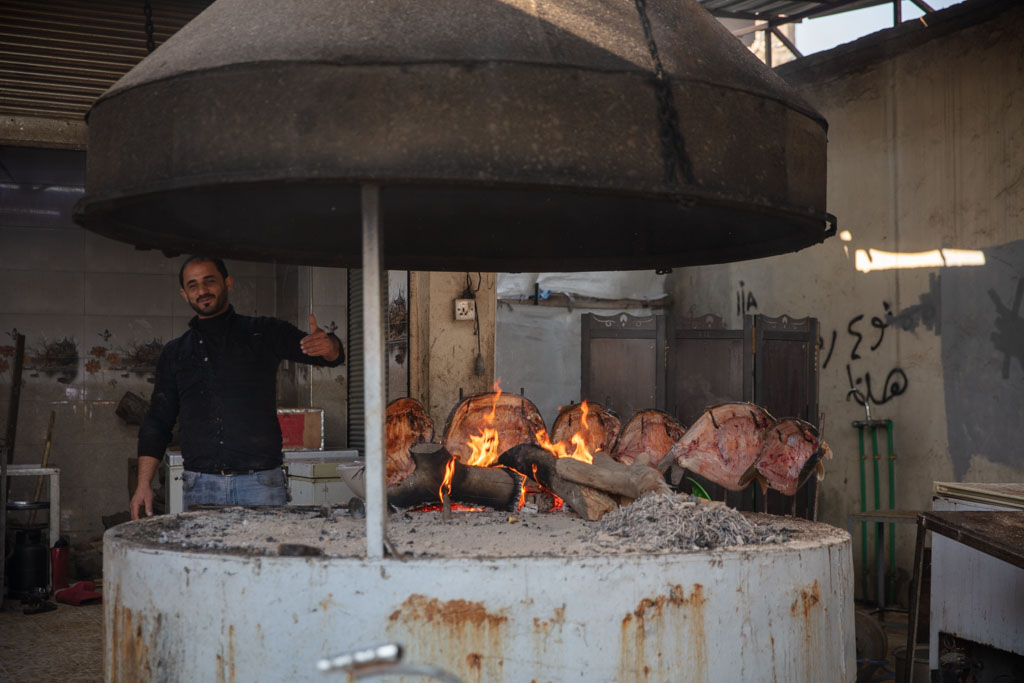
Al Kadhimiyah Mosque is located in a neighborhood of northwest Baghdad, so get a taxi/Careem over there. You will walk through a big pedestrianized souq area to reach the mosque that is the perfect place to pick up an abaya (the all-enveloping bedsheet women must wear to enter the mosque) and Iraqi sweets.
Al Kadhimiyah Mosque is an important site for Twelver Shias as the 7th (Musa al Kadhim) and 9th (Mohammed al Jawwad) imam’s tombs are inside the mosque. The mosque is quite exquisite to see lit up in the dark and is quite lively in the evening, though, if you’ve never been to an Islamic mosque/shrine like this before it can feel a bit overwhelming.
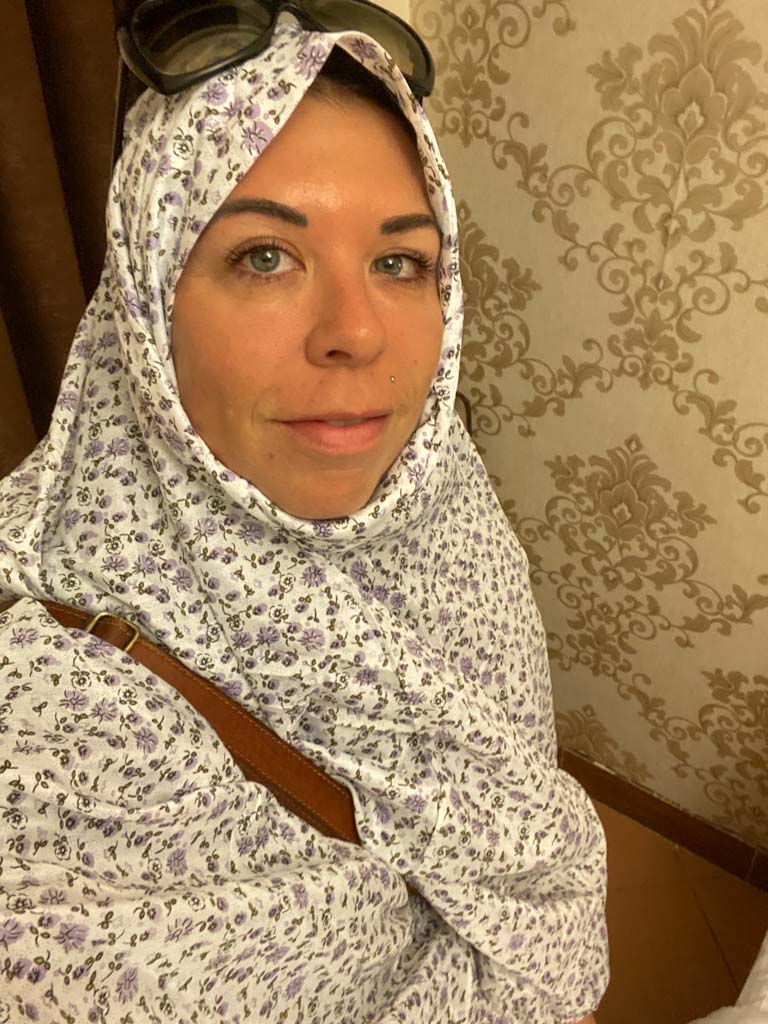
To enter the mosque you must remove your shoes and leave them in a designated area. You’re also not allowed to bring in electronics like cameras, phones, batteries, etc, but there is a counter where you can deposit them and pick them up with a token after you’re finished.
The mosque is gender-segregated (basically every holy site you’ll visit will be), so women and men have different entrances to al Kadhimiyah where you’ll first go through a security pat-down. Women must wear the chador as I said earlier and one can be picked up for 5,000- 10,000 IQD in the souk.
Not sure what to wear in Iraq? Check out the ‘what to wear’ section of my Iraq Travel Guide for tips (it’s not as conservative as you think it is!)
Getting Around in Baghdad
You’ll notice me referencing using a Careem quite a bit in this article for getting around in larger cities by private taxi. Careem is more or less the same as Uber, so it takes the hassle out of negotiating prices with taxi drivers. Careem operates in and around Baghdad, Najaf/Kufa, and Basra.
Recommended Hotels in Baghdad
Day 2: Samarra & Baghdad
Day 2 Iraq Itinerary: Al Shaheed Monument, Malwiya Minaret, Grand Mosque of Samarra
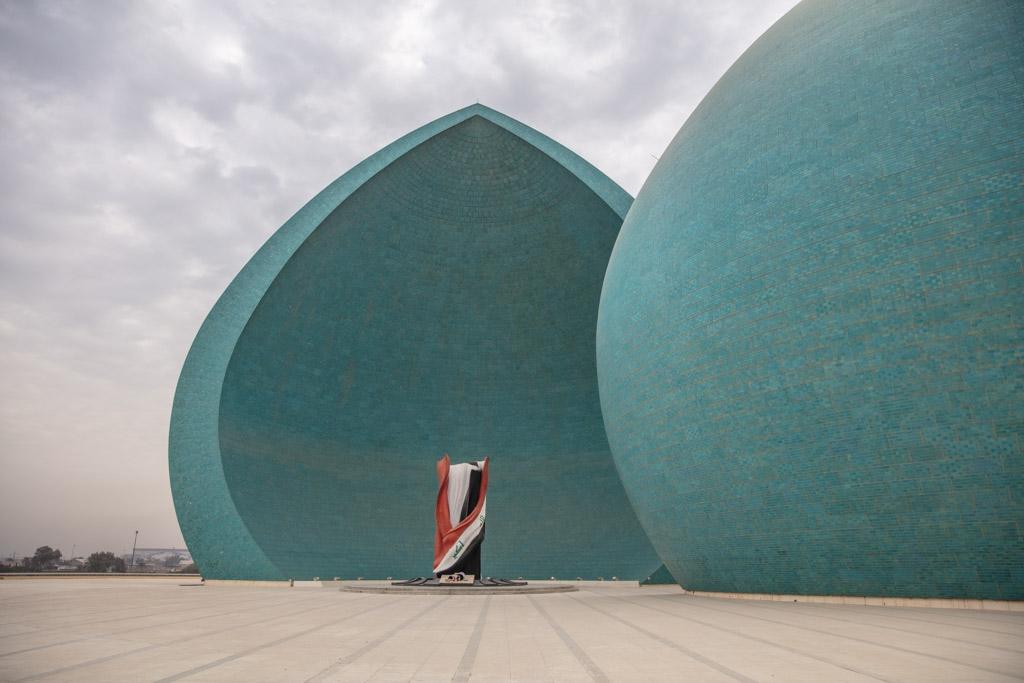
Get an early start on your second day in Iraq and head to the Al Shaheed Monument, also known as the Martyr’s Monument. You’ve likely seen photos of the Al Shaheed Monument if you’ve begun any research into visiting Baghdad as they are the famous giant blue eggs as many tourists will call them. But the monument is more than just a couple of pretty buildings- it’s an entire monument to commemorate the Iraqis who lost their lives during the long Iran-Iraq War.
Make sure to enter the museum and library beneath the Martyr’s Monument to learn more about the Iran-Iraq War.
Entrance to the Al Shaheed Monument costs 3,000 IQD.
Next, it’s time to head north from Baghdad to make a day trip to Samarra. Expect the drive to Samarra to take about two and a half hours. One thing to note is that Samarra is a bit of a pain to visit as you will need to pass through a checkpoint manned by the Shia militant group Saryat as Salaam and they are pretty suspicious of outsiders, especially foreigners.
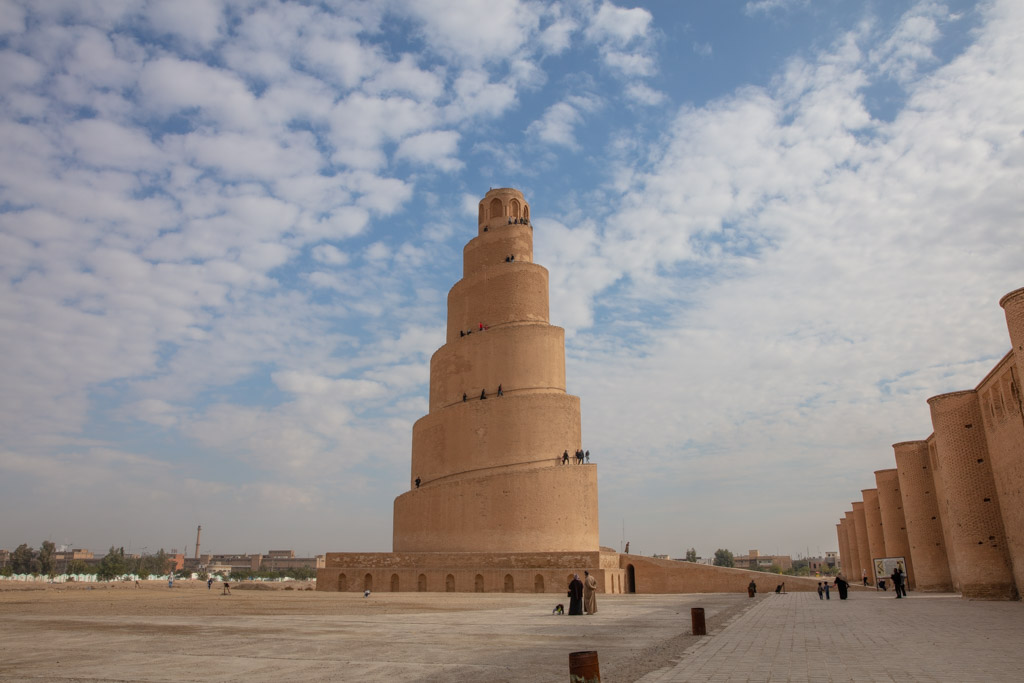
Once through the checkpoint, you can make a beeline for the Grand Mosque of Samarra and its iconic Malwiya Minaret.
At its zenith, the Grand Mosque of Samarra was the largest mosque in the world, completed during the 9th century under the Abbasid era. Of course, no visit to Samarra would be complete without a walk up the spiraling 52 meter tall Malwiya Minaret. From the top of Malwiya Minaret, you’ll have the best views of the Grand Mosque of Samarra below as well panoramic sceneries of the sprawling city of Samarra.
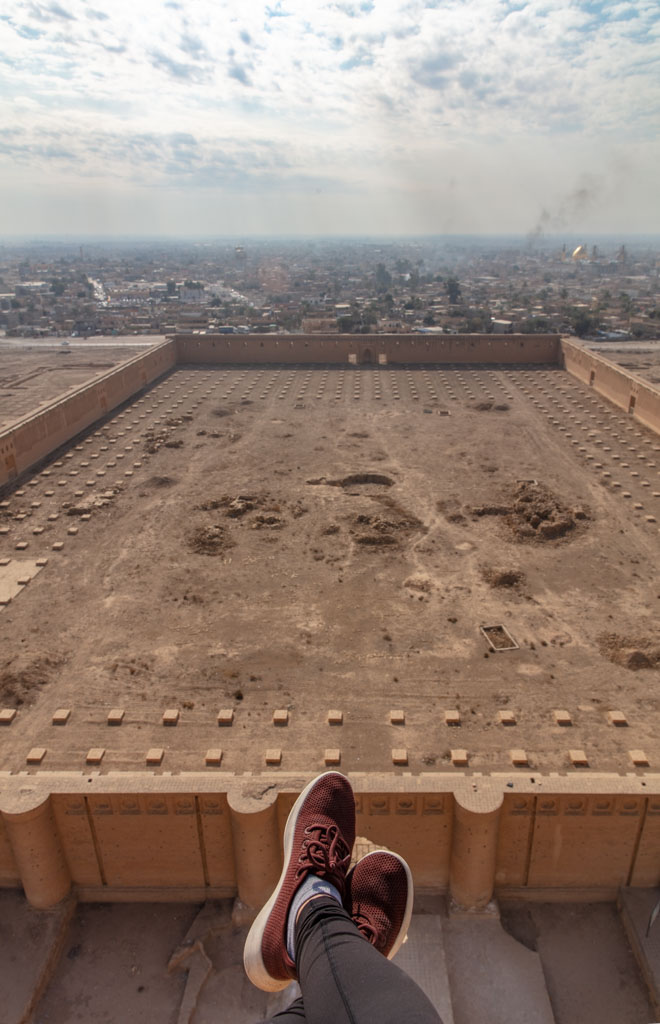
Once you’ve had some time to take in the Grand Mosque, grab some lunch, and then make your way back to Baghdad for the evening.
Getting to Samarra from Baghdad
For shared taxis to Samarra, go to Allawi Garage. A seat in a shared taxi should cost about 15,000 IQD. You can also opt to pay for all the other seats (usually there are four pax per car) if you’d like a private drive.
If you are traveling independently, it would be smart to try to visit with some locals from Baghdad (you can meet heaps of friendly people on the Iraqi Travellers Cafe Facebook group) or to at very least have contacts in Samarra (again, Iraqi Travellers Cafe can help you find some), otherwise, I would recommend hiring a guide to go out there. Whether you go at it independently or guided, so expect to spend some time at the checkpoint, just be patient (though going guided you may spend a little less time waiting around).
Getting Back to Baghdad from Samarra
From the main Samarra Garage, you should be able to find a Baghdad-bound shared taxi. If not, you can always pay for the other seats.
Day 3: Babylon & Karbala
Day 3 Iraq Itinerary: Babylon, Saddam’s Babylon Palace, Imam Hussein Shrine, Imam Abbas Shrine
Get another early start on day three of your Iraq itinerary as you’ll be hitting the road to the south to visit the sites of Babylon, Saddam’s Palace in al Hillah, and the famous shrines in Karbala.
After about 90 minutes to two hours after leaving Baghdad, depending on traffic, you’ll arrive al Hillah from where you can get a taxi to the famous Ishtar Gate, the entryway to the ancient city of Babylon. It’s worth noting that the beautiful blue Ishtar Gate you’ll pass under to go inside is a replica, the original is in the Pergamon Museum in Berlin. The gate is adorned with lions, bulls, and the mythical Mesopotamian dragon god Marduk.
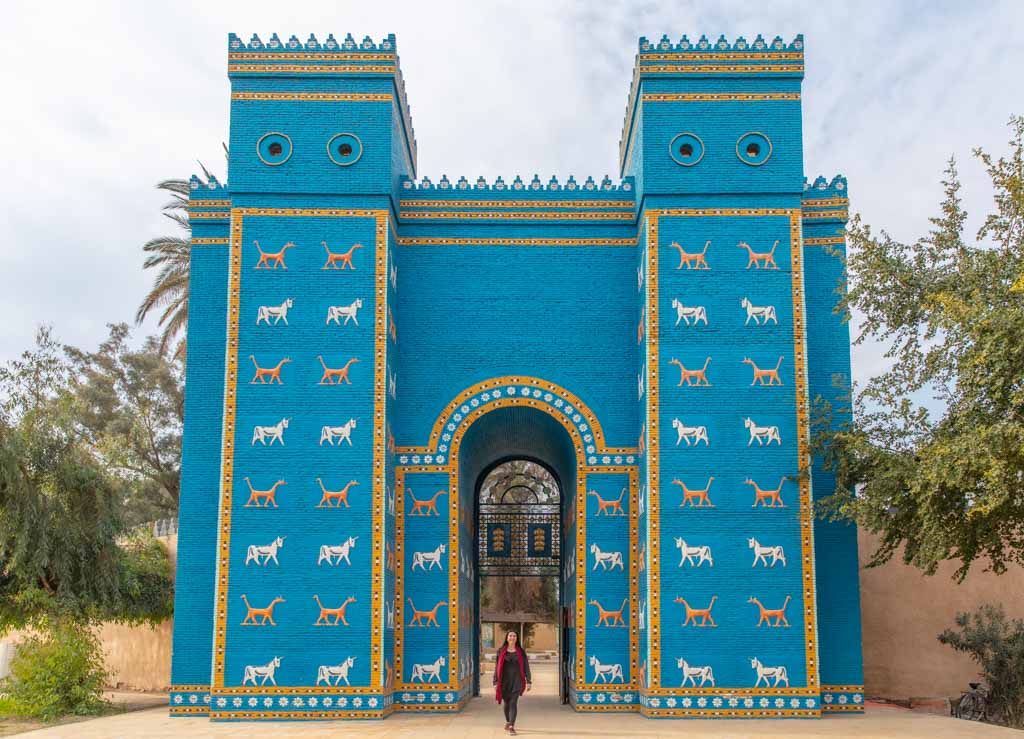
Once inside the gates of Babylon, highlights include the Babylon Museum (I would recommend going inside it first to get some context on what all you’re about to see, the walls decorated with Babylonian gods, and the massive Labyrinth of Babylon where Alexander the Great was finally slain. Another important thing to see in Babylon is the Lion Statue, built under the orders of the Chaldean Babylonian king Nebuchadnezzar.
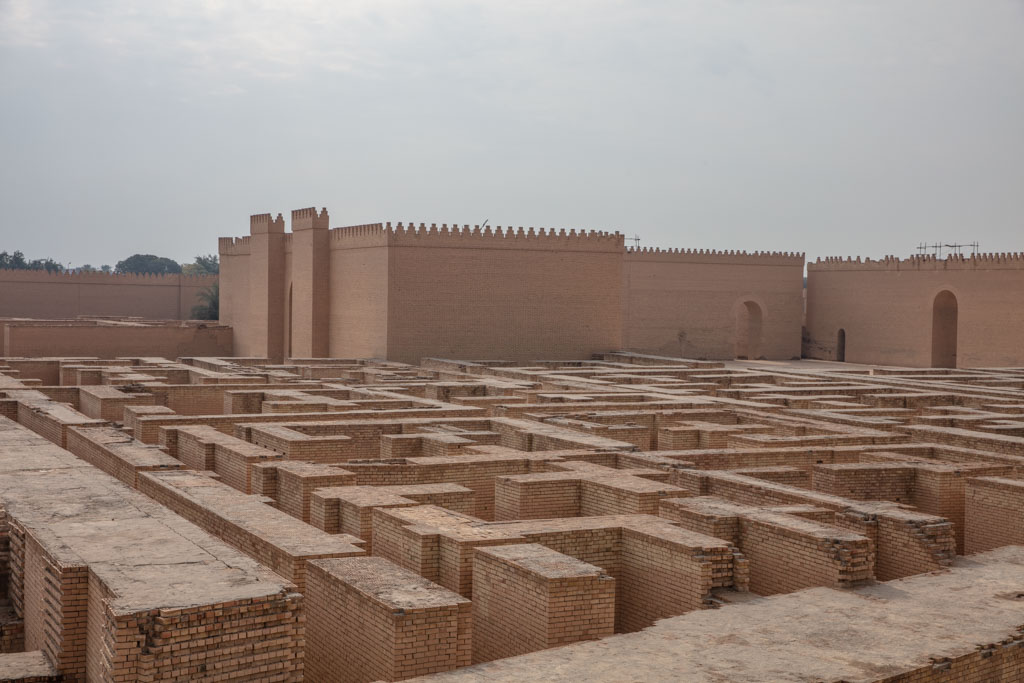
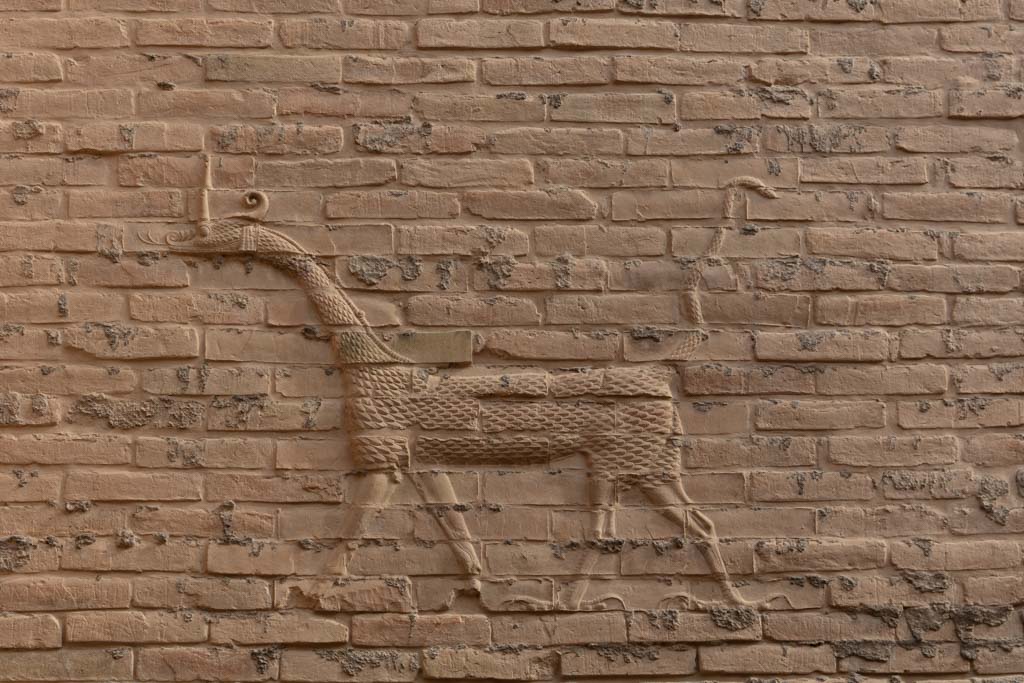
Entrance to Babylon is 25,000 IQD for foreigners.
Once you’ve wrapped up your Babylon sightseeing, you’ll next make the walk over to Saddam’s Babylon Palace which you have surely seen looming over ancient Babylon. After you’ve had a chance to see the palace, grab lunch in al Hillah and then head to Karbala.
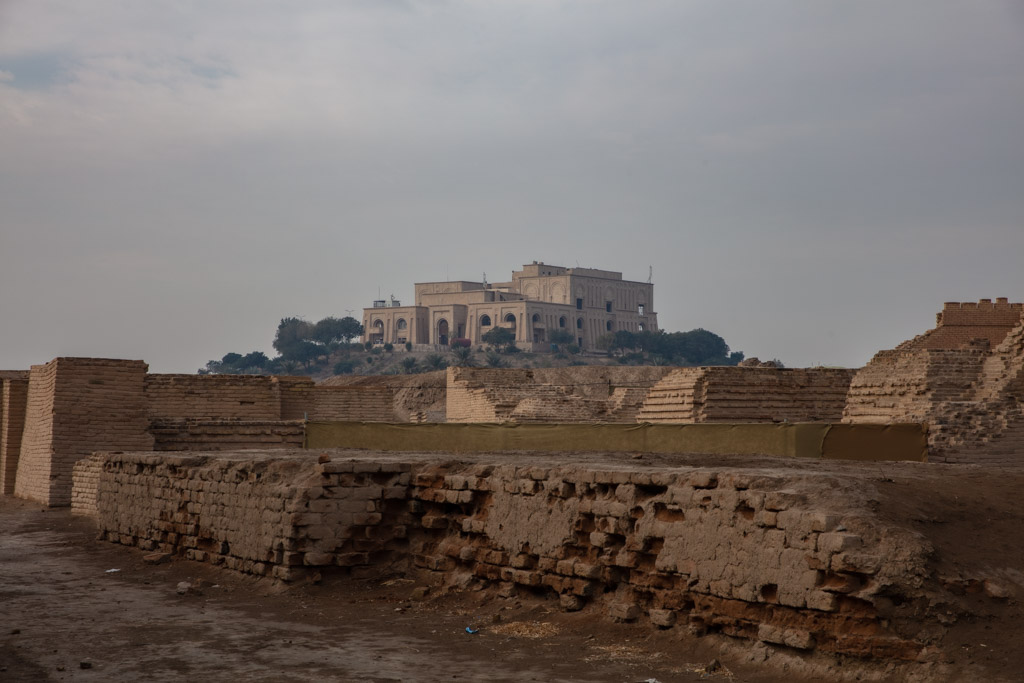
Getting from Baghdad to Babylon (al Hillah)
Go to Al Nahda Garage in Baghdad to find shared taxis plying the route to destinations south of the city. A seat in a shared taxi to al Hillah should cost around 10,000 IQD and from there you can hire a taxi to drop you off at Babylon for about 6,000 IQD.
Getting to Karbala from al Hillah
Head into al Hillah proper to the Karbala Garage. You should be able to find a seat in a shared taxi to Karbala for 2,000 IQD.
Finally, your last stop for day three is the holy city of Karbala. Karbala is one of the most important cities in both Iraq and for Shia Muslims as it is home to the largest Islamic ziyarat (pilgrimage) called Arbaeen that falls 40 days after Ashura. Roughly 20 million Shia come from all corners of the world for Arbaeen each year to honor Imam Hussein who was martyred in the 7th century in the Battle of Karbala.
Since Karbala is one of the holiest of Iraq’s holy cities female travelers will need to be wearing a chador to enter the first checkpoint to the city. If you didn’t purchase in Baghdad already you can easily buy one off the streets leading into Karbala.
So, with all that said, the Shine of Imam Hussein is likely going to be your first stop. Make sure you’re completely covered (ladies anyway) and head on in. The shrine, like most all you’ll visit in Iraq, is gender-segregated. First go to your gender’s desk where you’ll drop off shoes, cameras, batteries, etc. (smartphones are allowed inside, yay!) From there, you’ll go to your gender’s entrance and go through the usual security pat-down before entering the shrine.
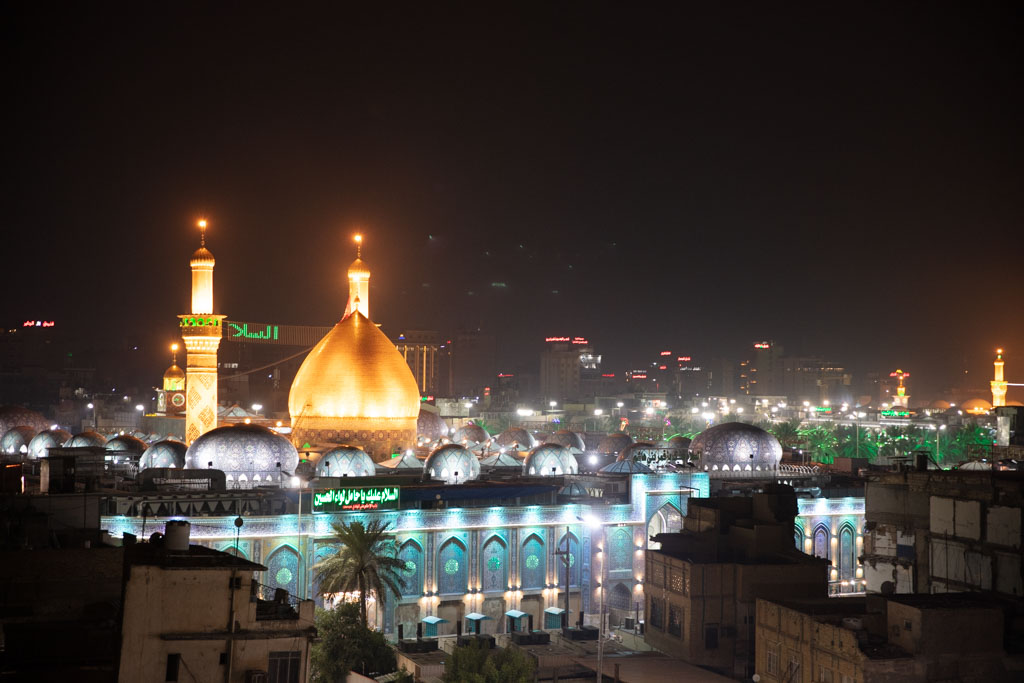
The shrine features dazzling mirrored glass ceilings and beautiful glazed tile walls. You can of course go inside where the tomb is too- but know that it’s crazy crowded and quite the experience- you’ll see people wailing and sobbing while other’s happily snap pictures on their phones while exclaiming mashallah! as the guards (ladies in my case) wag green feather-dusters at the ones holding up traffic too long.
I’d recommend finding a good spot to sit on the carpet somewhere in the shrine to people-watch and admire the architecture.
Once you’ve had enough of Imam Hussein Shrine, walk next door to Imam Abbas Shrine. Imam Abbas is the brother of Imam Hussein, who was also martyred in the Battle of Karbala on the day of Ashura and buried inside this mausoleum. Its interior architecture bears a lot of similarities to Imam Hussein’s, though I thought the atmosphere was a bit more chill (I think this may have been because it felt a little less crowded to me).
Recommended Hotels in Karbala
Going to Iraqi Kurdistan too? Check out my guide to traveling Iraqi Kurdistan and plan your visit
Day 4: Najaf & Kufa
Iraq Itinerary Day 4: Imam Ali Shrine, Wadi as Salaam, Grand Mosque of Kufa
On the morning of your 4th day in Iraq, you’ll make way to the holy city of Najaf.
Najaf is another important holy city for the Shia as Ali, the Prophet Mohammad’s cousin and brother-in-law is buried here. Because of this, Najaf, much like Karbala is another important pilgrimage site.
The main draw in Najaf is of course the Imam Ali Shrine. The shrine features a mosque completely decked out in gold and the shrine also houses the tombs of several other important prophets. By now, you’ve likely gotten the entrance protocol to shrines down pat, and Imam Ali is no different.
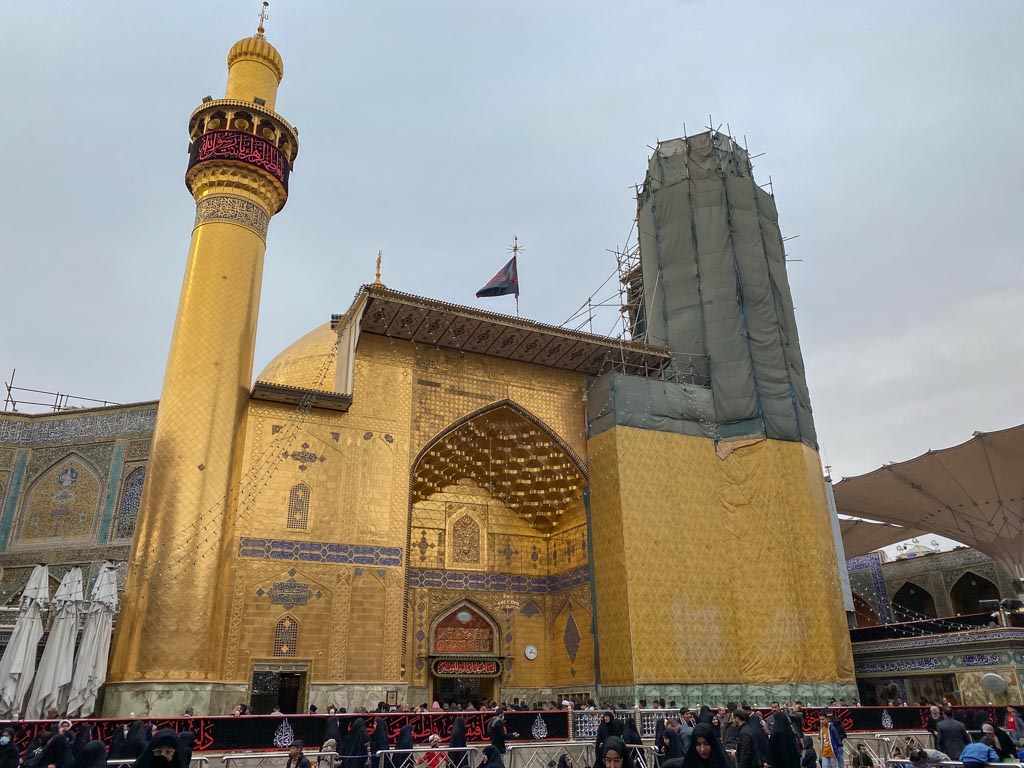
Within walking distance of the Shrine of Imam Ali, you’ll arrive at the largest cemetery in the world- Wadi as Salaam (Valley of Peace). Wadi as Salaam contains over 5 million graves and even to this day many Shia ask to be buried here among the holy.
Once you’ve had a chance to check out Wadi as Salaam, grab lunch in Karbala and then grab a taxi or Careem to nearby Kufa (about 3,500 IQD). Ask your taxi driver to drop you off at the Grand Mosque of Kufa.
The Grand Mosque of Kufa is among the oldest surviving mosques in the world, dating back to the 7th century. The mosque was the home of Imam Ali and houses shrines of Muslim Ibn Akeel, al Mukhtar, and Hani Ibn Urwa. Several interesting legends surround the mosque too.
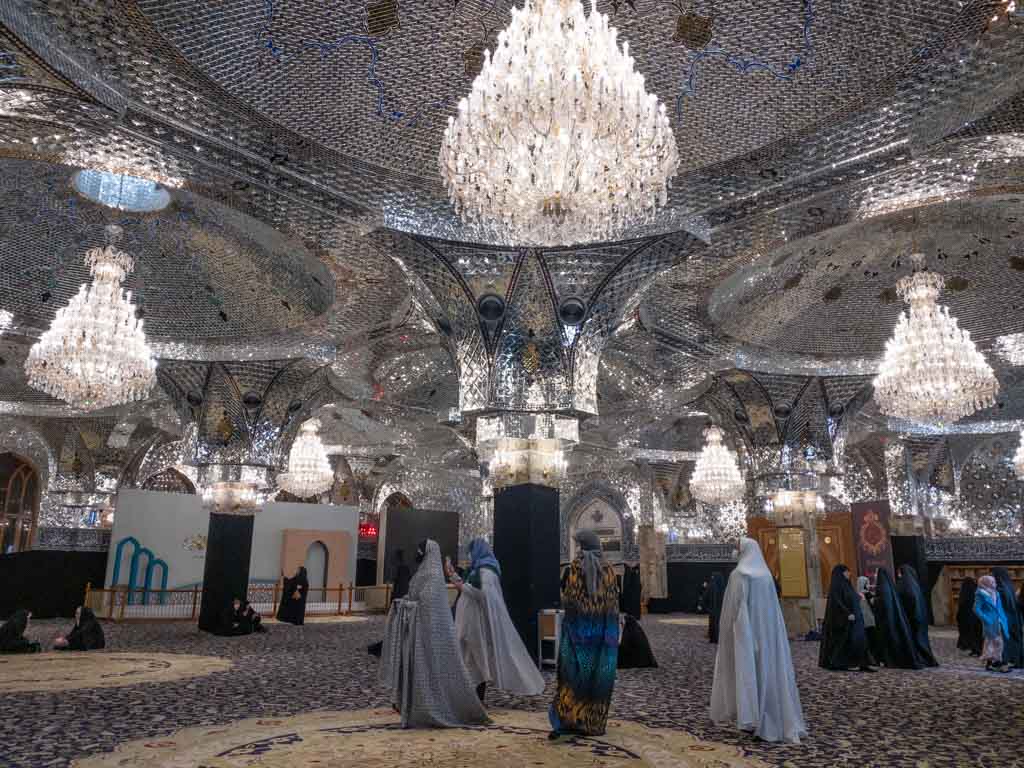
Once you’re finished sightseeing in Kufa you can grab a taxi back to Najaf for the night.
Getting to Najaf from Karbala
Shared taxis depart the main garage in Karbala for Najaf. A seat should cost around 3,000 IQD.
Recommended Hotels in Najaf
Day 5: Ur & Nasiriyah
Day 5 Iraq Itinerary: Ziggurat of Ur, Nasiriyah
Going to Nasiriyah, like going to Samarra is also a pain but for different reasons. Security around Nasiriyah is pretty tight because of the high-security al Hoot Prison that holds many accused ISIS and al Qaeda members, located on the outskirts of Nasiriyah on the way to the Ziggurat of Ur.
There’s not much to see in Nasiriyah itself but it is a great jumping-off point for adventures into the Mesopotamian Marshes. If you have time in Nasiriyah it’s worth taking the time to stroll along the Euphrates River and visit the Nasiriyah Museum. The biggest attraction around Nasiriyah though is the Ziggurat of Ur.
Built by the Sumerians, Ur was a city-state within Mesopotamia that dates back to 2200 BC. The Ziggurat of Ur is impressive and is worth climbing up all the stairs to get 360º views from the top. It’s among the best-preserved ziggurats still left standing.
Entry to the Ziggurat of Ur is 25,000 IQD. They usually hold your passport at the entrance and have you pay when you’re leaving.
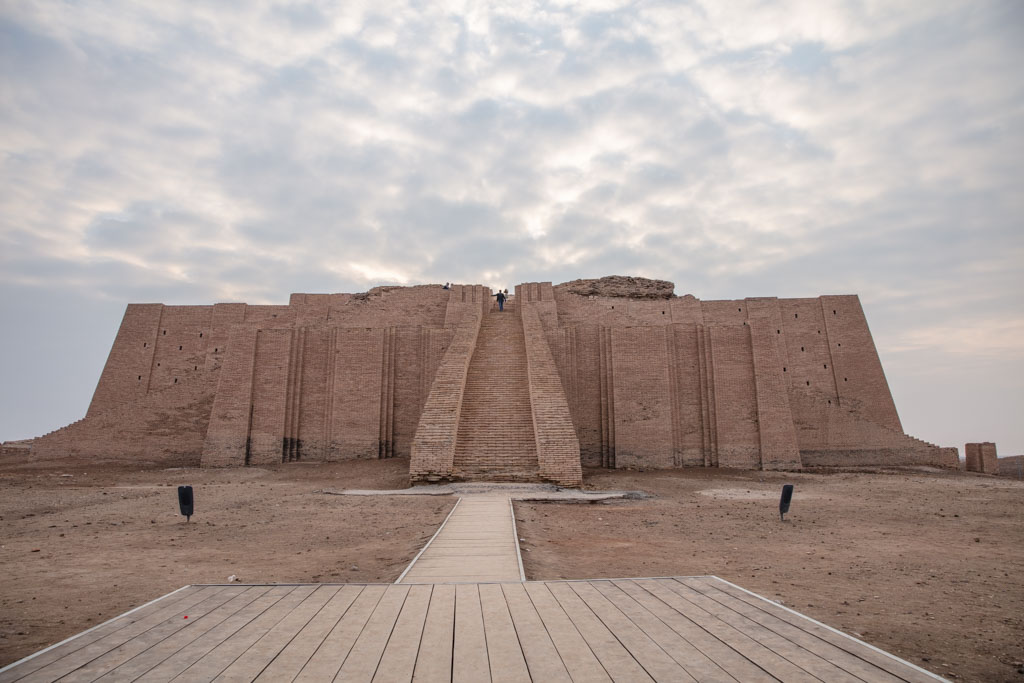
Getting to Nasiriyah from Najaf
You can find shared taxis to Nasiriyah from the main garage in Najaf for about 15,000 IQD per seat.
If you’re visiting Nasiriyah as part of a guided trip, then no worries, you’re guide will handle the headache for you, but if not you’ll have some hoops to jump through.
For those going at it on their own, you will need a sponsor in Nasiriyah to get past the Nasiriyah Checkpoint (again the Iraqi Travellers Cafe Facebook group will help you find someone to sponsor you). If coming from Najaf, you’ll likely arrive at the checkpoint about three hours later so plan this accordingly with your sponsor so that they can meet you there because typically the police will not let you leave until they have your sponsor there for registration.
Getting to the Ziggurat of Ur
If you’re not visiting on a tour, you can get a taxi from Nasiriyah to Ur and back including waiting time for around 10,000 IQD. Note that some people have difficulties getting past the checkpoint and some enter the site while others seem to have no issues- I think it really just depends on who is working and what mood they’re in that day.
Recommended Hotels in Nasiriyah
Day 6: Mesopotamian Marshes
Day 6 Iraq Itinerary: Hammar Mesopotamian Marshes, Basra
Taking a mashuf ride (traditional canoe-like boats) in the Mesopotamian Marshes is an awesome highlight of visiting Southern Iraq. Not only is the area incredibly beautiful but also is home to the fascinating culture of the Ma’dan (Marsh Arabs).
The Mesopotamian Marshes are a massive wetland complex formed by the Tigris-Euphrates River System. The most accessible area of the marshes is the Hammar Marshes, also called al Chibayesh, but there are also al Qurnah and al Amarah for those looking to get a bit further out.
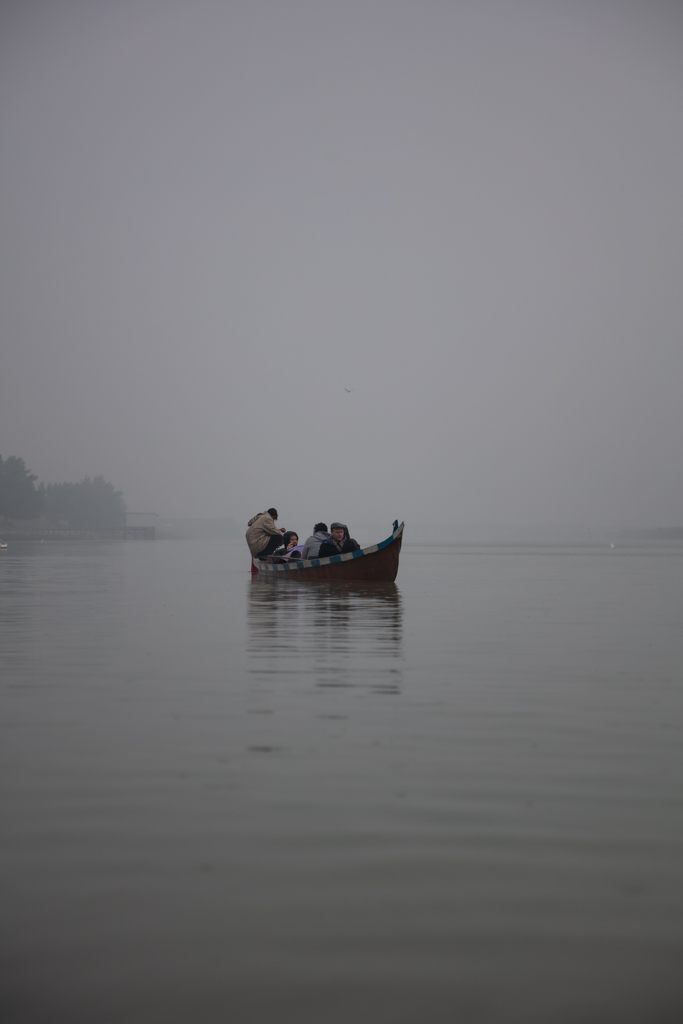
Boats can be hired to go into the marshes from the Martyrs Monument for about 30,000 IQD for a short 30 minute trip. If wanting to go deeper into the marshes on a longer journey you’ll need to negotiate a price, though if you make arrangements in advance you can likely do a longer trip for a cheaper price. Abo Haidar is who I went with and is probably the most well-known guide in the Mesopotamian Marshes.
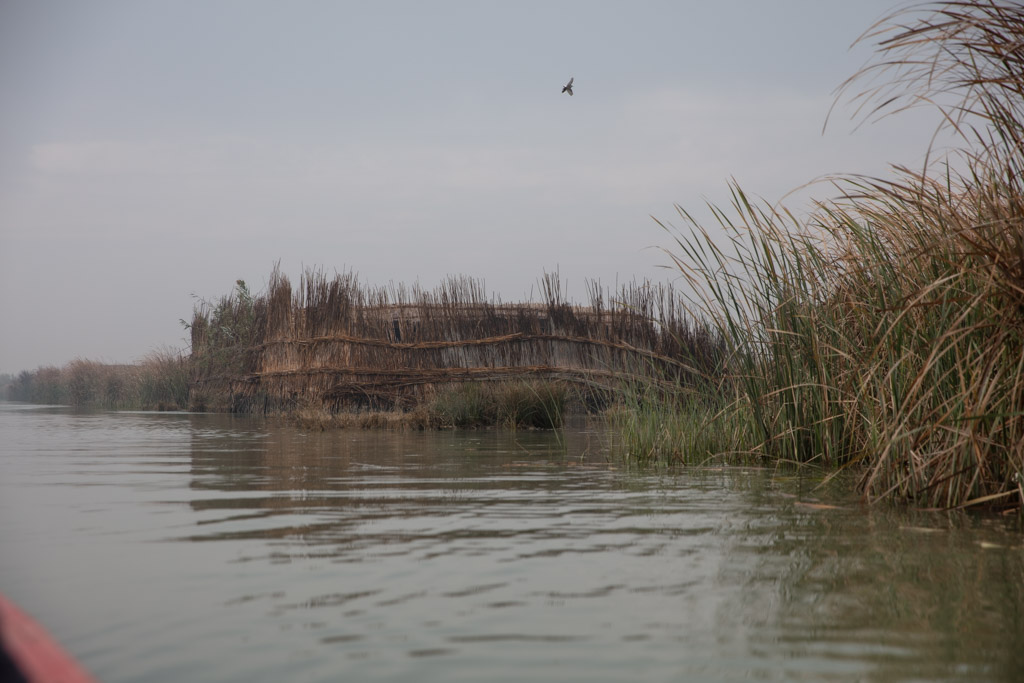
If you have extra time to spare in the Mesopotamian Marshes you may want to try and arrange an overnight stay in a traditional reed house.
Once you’re done seeing the Mesopotamian Marshes, grab lunch (I’d recommend some fresh masguf) before continuing your journey to Basra.
Getting to the Mesopotamian Marshes and to Basra
You can find shared taxis to Chibayesh from Nasiriyah for 3,000 IQD per seat, or if you want to make it easy on yourself as you do have quite a bit of ground to cover, you can hire a taxi to take you to Chibayesh and wait until your done in the marshes and then take you down to Basra for about 40,000 IQD.
Recommended Hotels in Basra
Day 7: Basra
Iraq Itinerary Day 7: Shatt al Arab, Shanasheel, fish markets
And last but not least on this 7 day Iraq itinerary is the southern city of Basra. Start your day with a morning boat ride on the Shatt al Arab to see some of the city’s main highlights from the water.
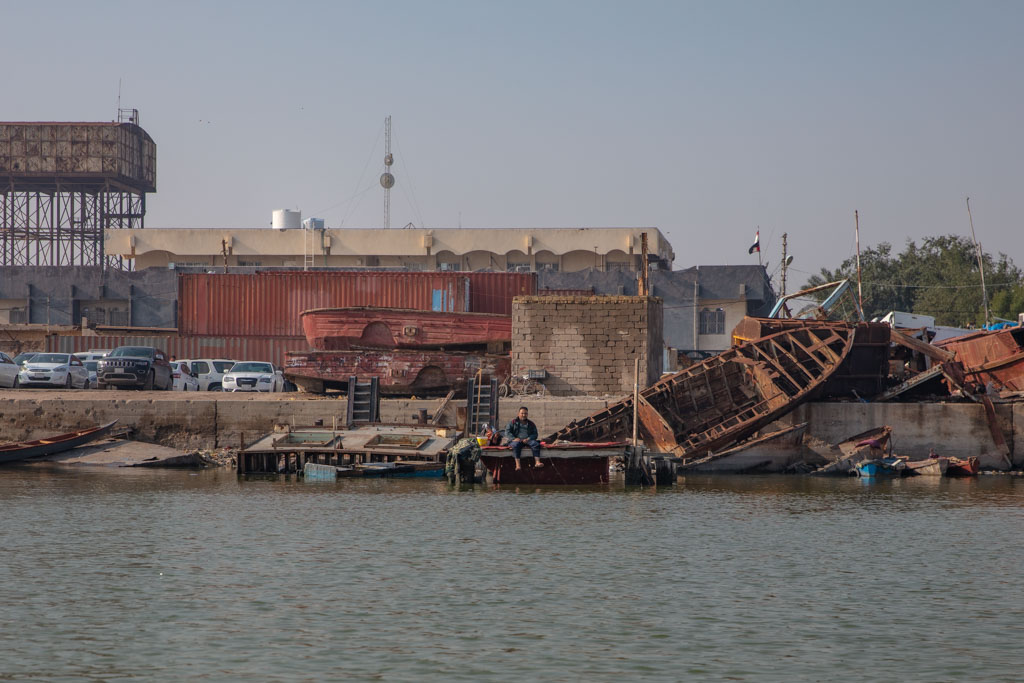
After the brief river cruise, take a Careem over to Basra’s Old City- Shanasheel to stroll the canals and streets and see traditional buildings and homes. Parts of the Old City are currently being restored after decades of neglect.
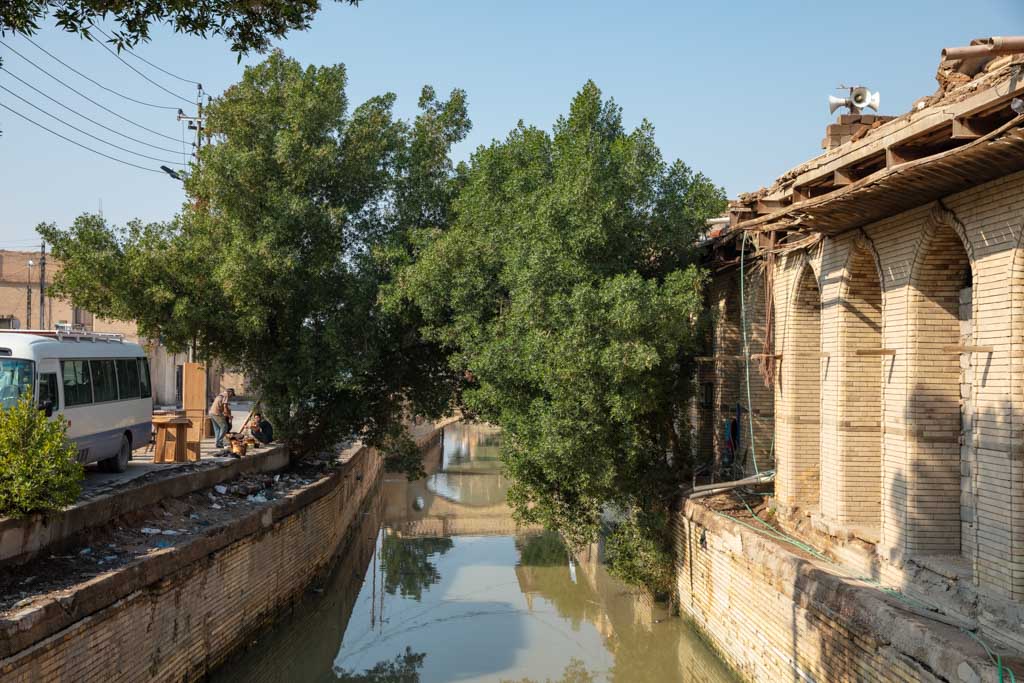
Finally, don’t miss the fish markets in Basra as they can be quite picturesque and atmospheric (and stinky). I went into the market a couple of times with my camera and many times the fishmongers and shoppers would stop me and ask to have their photos taken, so it was quite a fun spot in the city.
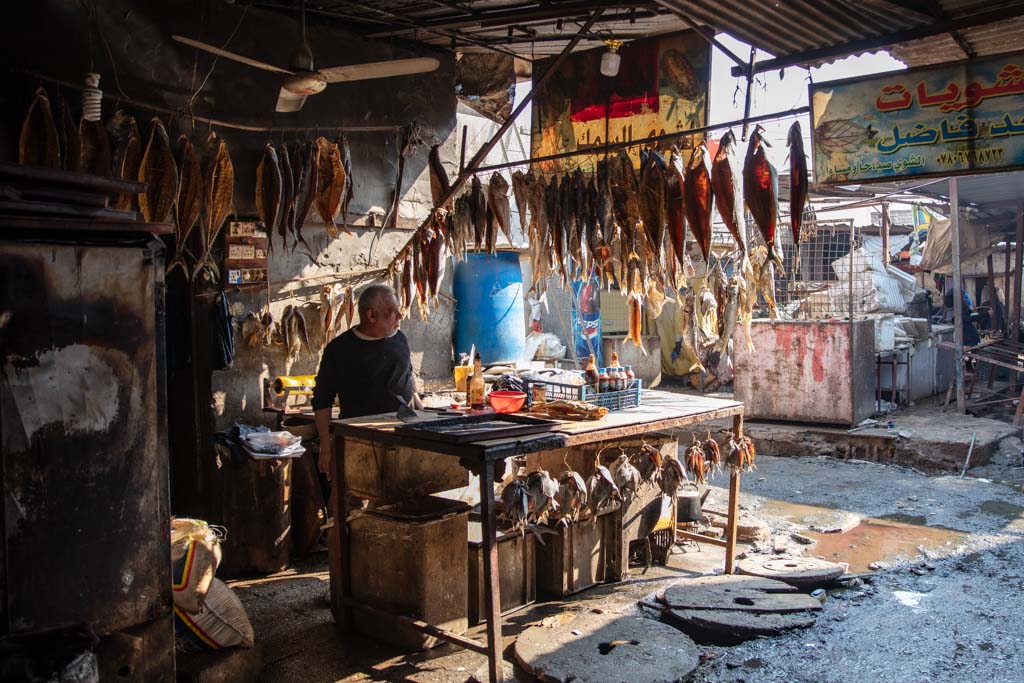
If you have time and can manage to get in, the Basra Museum is supposed to be worth a visit (I was denied entry with the claims of there needing to be some imaginary permit and then the story turned to “it’s closed”).
As your trip wraps up in Basra, you have two options for ending your trip. The first is to have open jaw flights, meaning you arrive in Baghdad and depart from Basra. The other option is to continue back to Baghdad (or beyond) by shared taxi, bus, or train.
Getting to Basra from Chibayesh
I would go to the main road along to the Euphrates River to try and find onwards shared cars to Basra, but I visited as a day trip with prearrangements to continue to Basra.
Please note that this itinerary can easily be reversed to start in Basra and end in Baghdad- this is especially helpful for those planning to continue onto Iraqi Kurdistan.
Getting to and out of Iraq: Airports and Red Tape
Starting back in March 2021, Iraq began a visa on arrival scheme for several nationalities making travel to Iraq easier than it’s ever been before (in more recent history anyway). These visas are available to travelers arriving at Baghdad, Basra, and Najaf International Airports at a cost of $77 USD.
There is wifi at the Baghdad Airport and there is a stall to buy SIM cards, but know that if you arrive late at night or early in the morning that it may not be open (I landed at 7 am and it was closed). There is also an exchange desk at the airport too, exchange just a little so that you have some cash for your taxi ride and a SIM card and then exchange the rest for a better rate in the city. You will see ATMs in the arrival hall but it’s fairly common for them to be out of cash.
Note that you still need to present a negative PCR test taken no less than 72 hours prior to arrival to enter Iraq whether you arrive in Baghdad, Basra, or elsewhere. You will more than likely need a PCR to exit Iraq to fly home or to your next destination, you can see a list of PCR testing facilities in Iraqi cities here.
Don’t want to go at it alone: Check out this one week Iraq group tour on offer by Safraty.
Arriving to Baghdad Airport
Once you’ve gotten your visa on arrival and cleared immigration, grab your bags and head outside and wait for a white shuttle bus. Take this shuttle bus (it costs 8,000 IQD). It will take you to a lot at Abbas Ibn Firnas Square outside the security zone of the airport and from there you can either take a taxi or Careem (should cost around 15,000 IQD) to Central Baghdad or wherever you’re staying in the city.
If the above is too big a headache for you there are certain taxis waiting in the lout just outside the arrivals hall and many of the drivers will be by the door saying taxi! taxi!. You can expect to pay anywhere from 30,000 to 45,000 IQD for one of these into Central Baghdad.
Have any questions about this one week Iraq itinerary?
Ask in the comments section below.
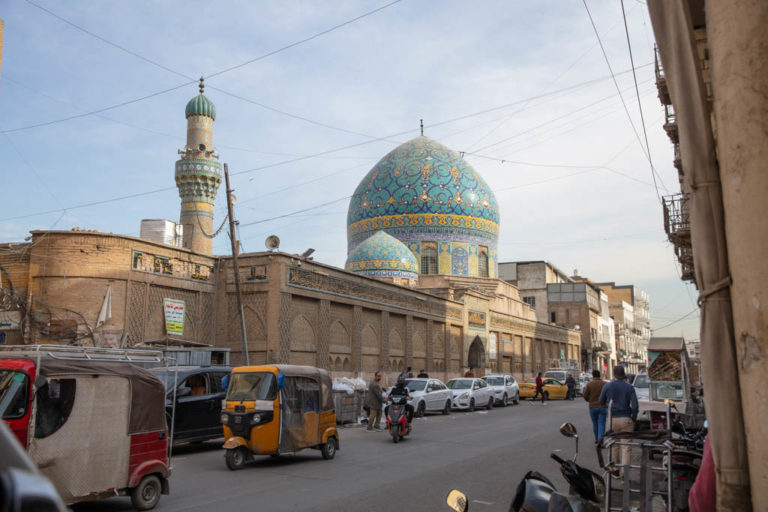
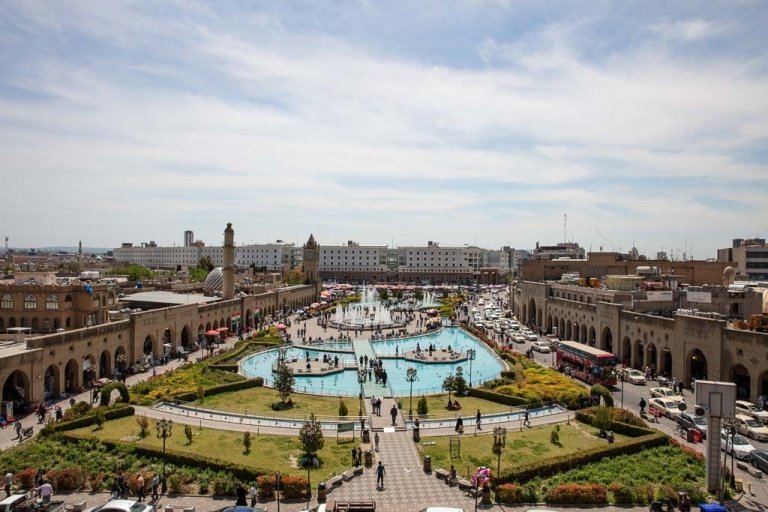
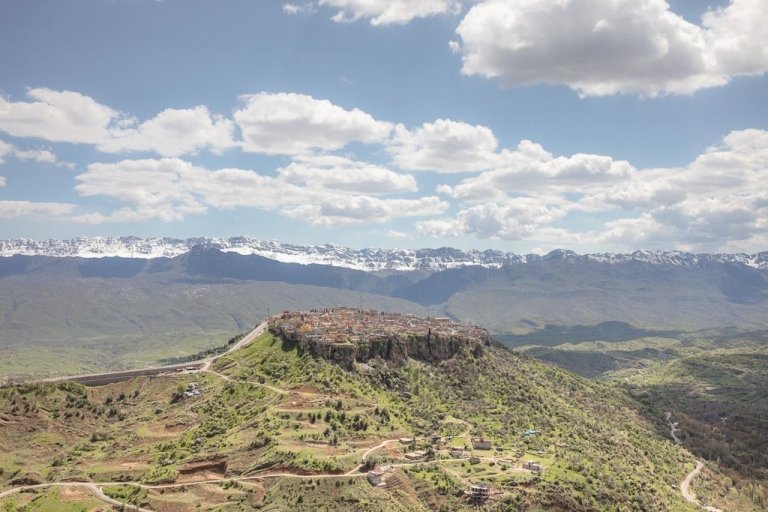
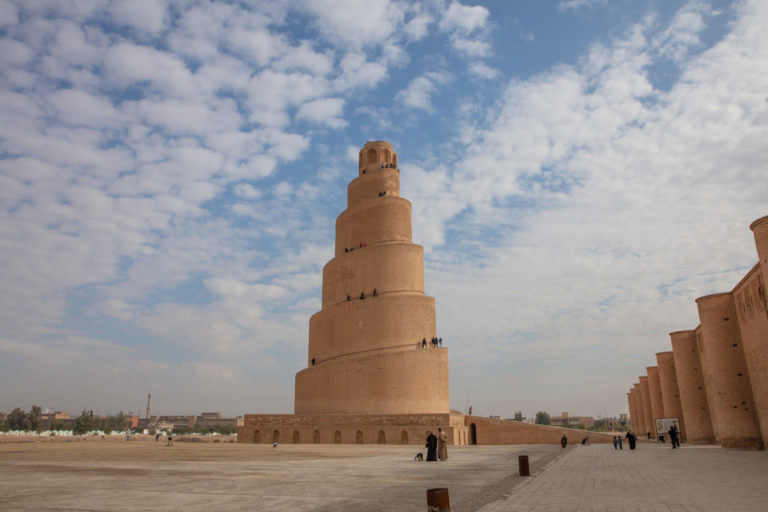
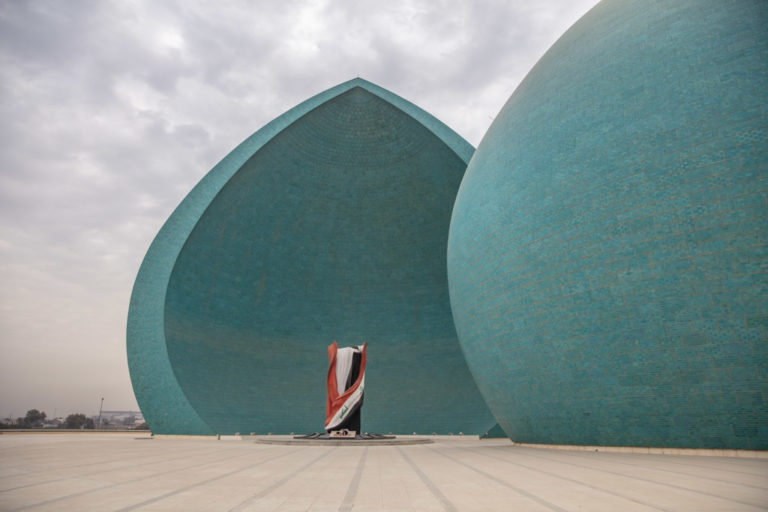
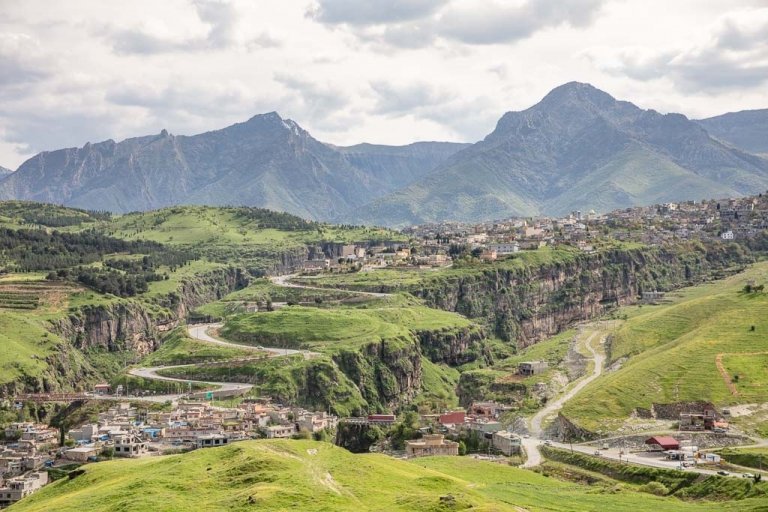
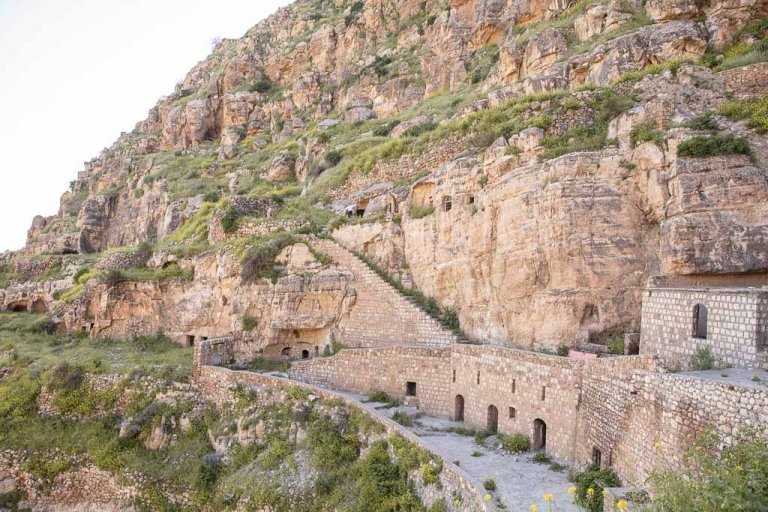
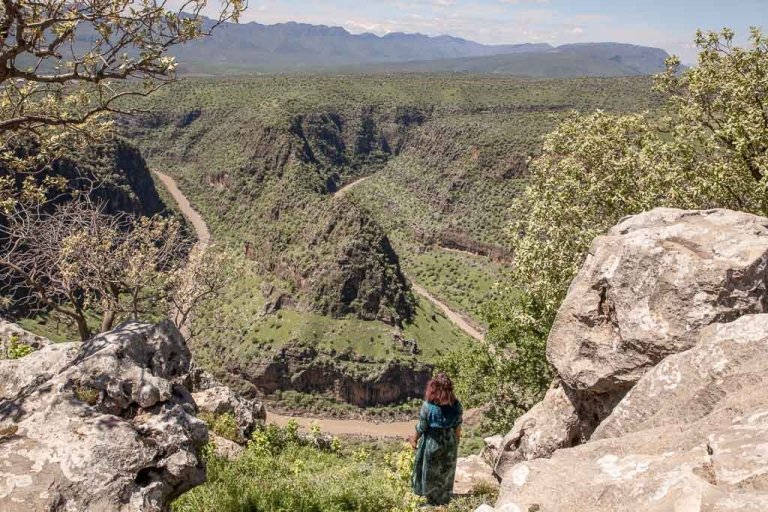
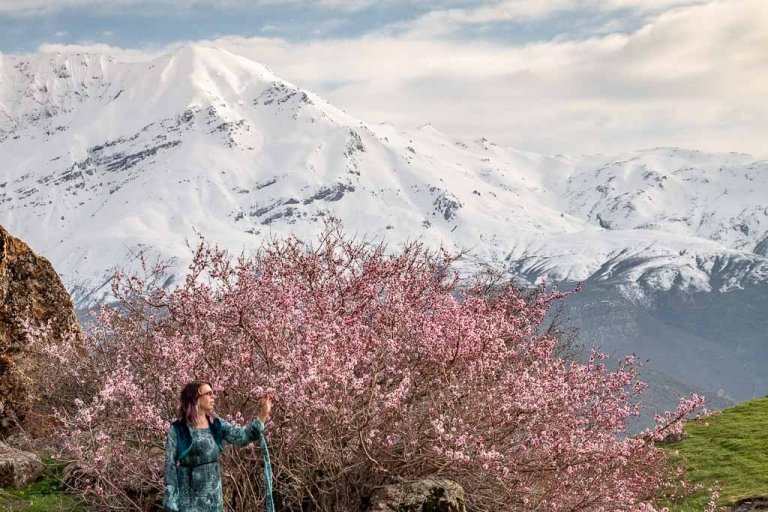
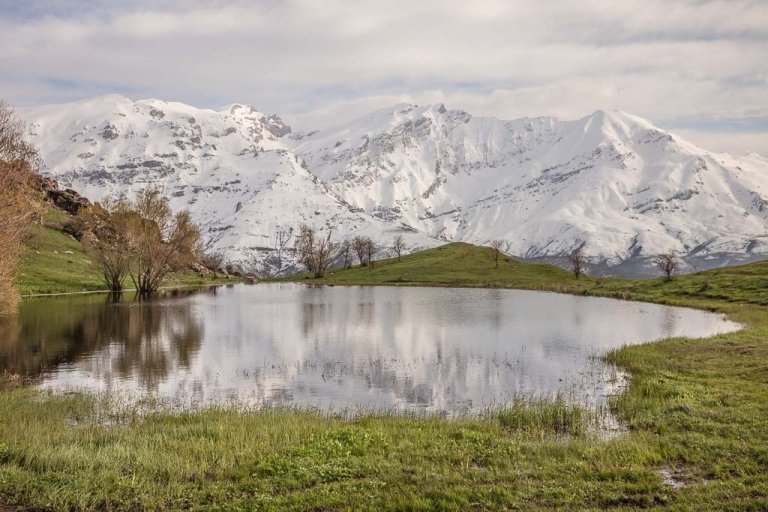
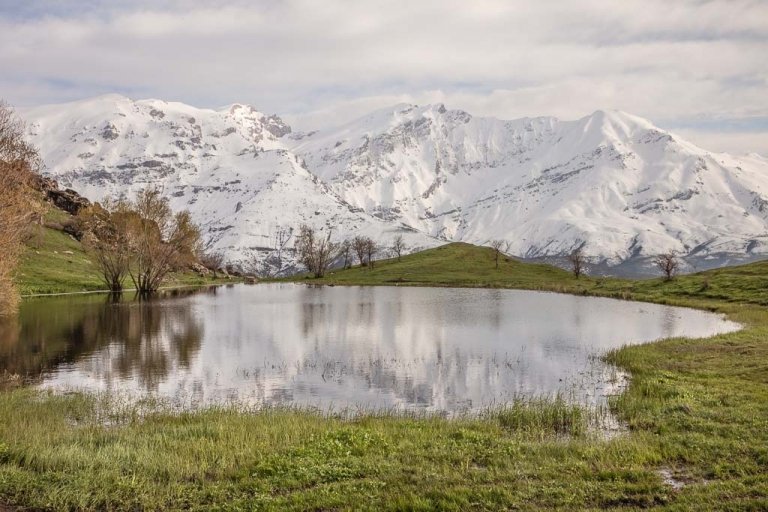
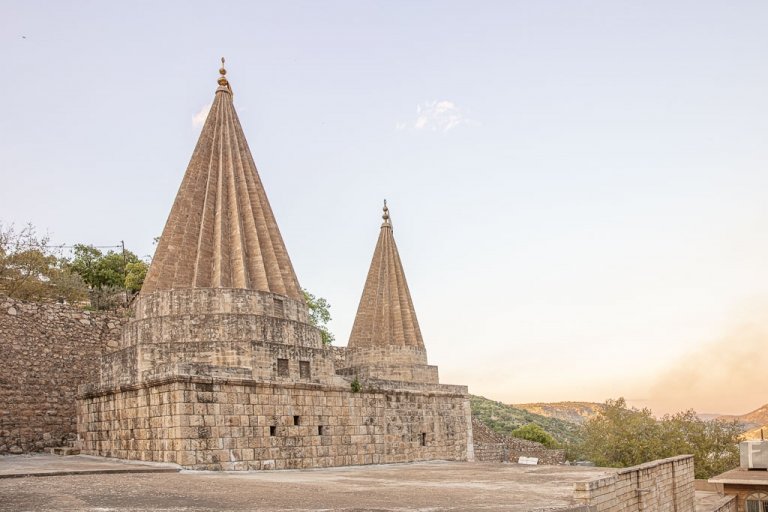
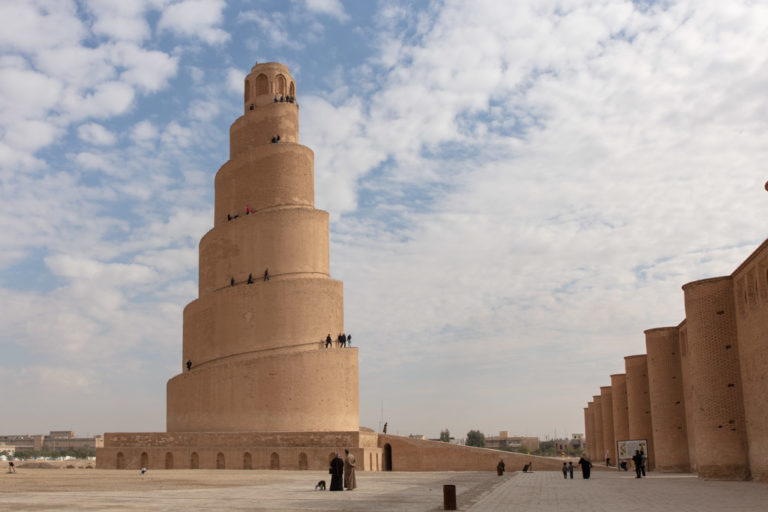
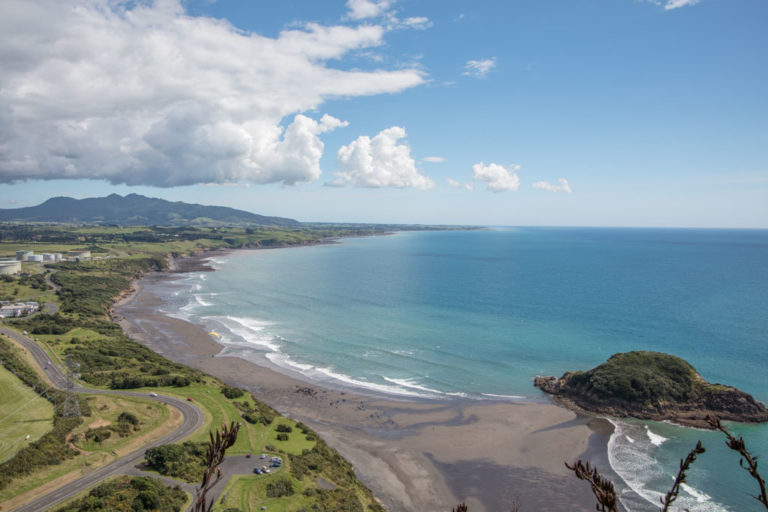
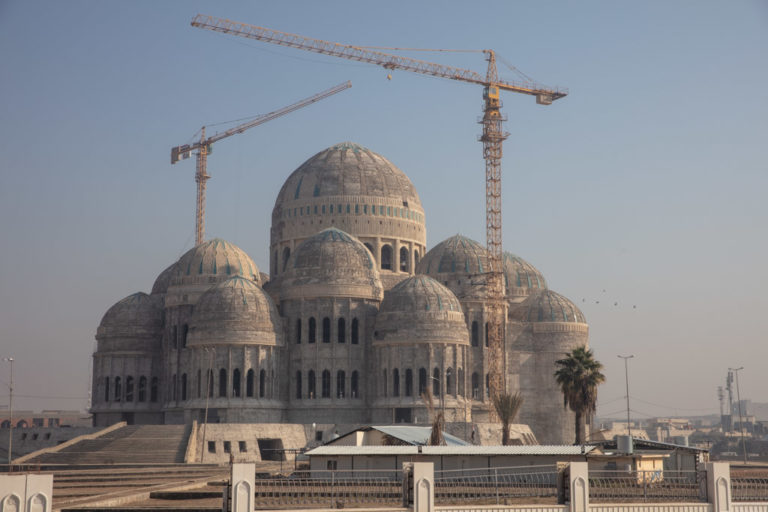
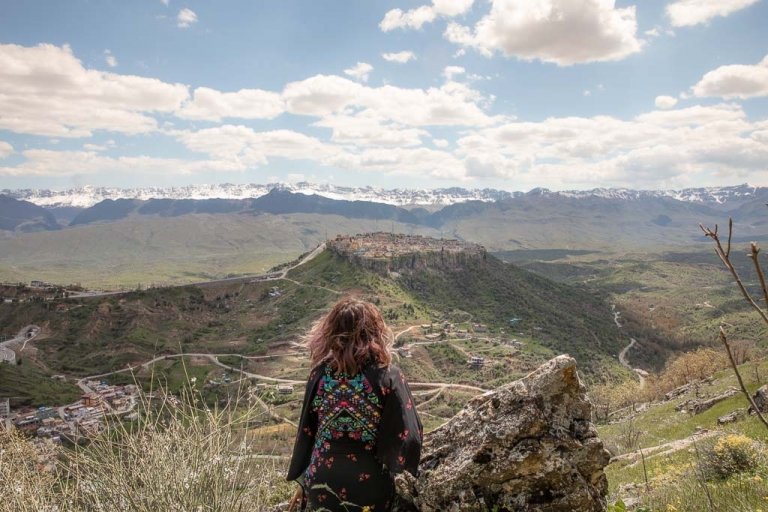
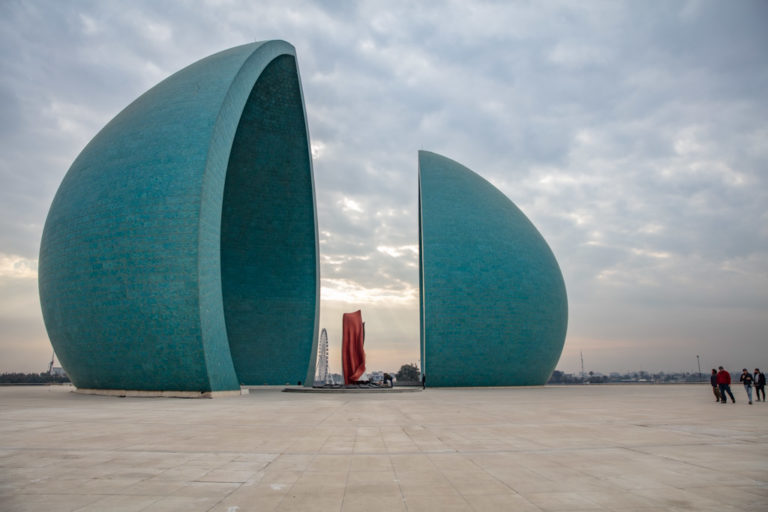
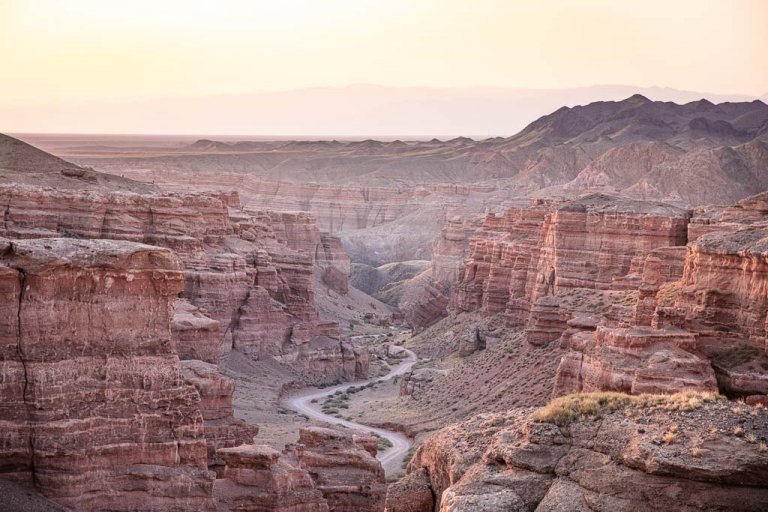
Can you go 100% independent or there are restrictions for US passport holders?
Yes you can! No restrictions on US passports either